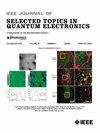III-V 注塑微盘和微oring 激光器的输出功率
IF 4.3
2区 工程技术
Q1 ENGINEERING, ELECTRICAL & ELECTRONIC
IEEE Journal of Selected Topics in Quantum Electronics
Pub Date : 2024-08-27
DOI:10.1109/JSTQE.2024.3450812
引用次数: 0
摘要
技术的进步使半导体激光发射器的尺寸大幅缩小到与发射波长相称的微米级成为可能。利用支持高 Q 值耳语画廊模式(WGM)的盘式或环形谐振器,可以实现激光器的极度微型化。WGM 激光器不仅体积小(模式体积小),而且光与物质的相互作用时间长,具有感知和研究量子混沌的独特能力,因此非常有趣。另一方面,高 Q 值谐振器中发射输出的微小损耗可能会抵消激光器的实际优势,甚至完全掩盖腔内光物理学的特殊性。在这篇综述中,我们试图总结已发表的有关不同 III-V 注入式微激光器达到的光输出功率的数据,并分析限制最大输出功率的关键特性,特别是 cw 工作时有源区自加热的影响和 WGM 腔内光提取的阻碍。我们比较了为提高输出功率而开发的各种 III-V 材料和制造方法。我们还在微盘激光器中观察到了极低的相对强度噪声,以及相对强度噪声频谱中谐振频率的谐波。本文章由计算机程序翻译,如有差异,请以英文原文为准。
Output Power of III-V Injection Microdisk and Microring Lasers
Technological progress makes it possible to significantly reduce the size of semiconductor laser emitters to microscales and sizes commensurate with the emission wavelength. Extreme laser miniaturization can be achieved using disk or ring resonators supporting high-Q whispering gallery modes (WGM). WGM lasers are interesting not only due to small sizes (small mode volume) but also for their long times of light-matter interaction, unique capabilities of sensing and studying of quantum chaos and so on. On the other hand, small losses for the output of emission in high-Q resonators can negate the practical benefits of the laser or even completely hide the peculiarities of the light physics inside the cavity. In this review, we attempted to summarize the published data on the achieved optical output power in different III-V injection microlasers and analyzed the key characteristics that limit the maximum output power, especially influence of the active region self-heating at cw operation and impeded light extraction out of WGM cavities. We compared various III-V materials and fabrication methods developed for improving emission output. We also observe very low relative intensity noise in microdisk lasers and harmonics of the resonance frequency in the relative intensity noise spectrum.
求助全文
通过发布文献求助,成功后即可免费获取论文全文。
去求助
来源期刊

IEEE Journal of Selected Topics in Quantum Electronics
工程技术-工程:电子与电气
CiteScore
10.60
自引率
2.00%
发文量
212
审稿时长
3 months
期刊介绍:
Papers published in the IEEE Journal of Selected Topics in Quantum Electronics fall within the broad field of science and technology of quantum electronics of a device, subsystem, or system-oriented nature. Each issue is devoted to a specific topic within this broad spectrum. Announcements of the topical areas planned for future issues, along with deadlines for receipt of manuscripts, are published in this Journal and in the IEEE Journal of Quantum Electronics. Generally, the scope of manuscripts appropriate to this Journal is the same as that for the IEEE Journal of Quantum Electronics. Manuscripts are published that report original theoretical and/or experimental research results that advance the scientific and technological base of quantum electronics devices, systems, or applications. The Journal is dedicated toward publishing research results that advance the state of the art or add to the understanding of the generation, amplification, modulation, detection, waveguiding, or propagation characteristics of coherent electromagnetic radiation having sub-millimeter and shorter wavelengths. In order to be suitable for publication in this Journal, the content of manuscripts concerned with subject-related research must have a potential impact on advancing the technological base of quantum electronic devices, systems, and/or applications. Potential authors of subject-related research have the responsibility of pointing out this potential impact. System-oriented manuscripts must be concerned with systems that perform a function previously unavailable or that outperform previously established systems that did not use quantum electronic components or concepts. Tutorial and review papers are by invitation only.
 求助内容:
求助内容: 应助结果提醒方式:
应助结果提醒方式:


